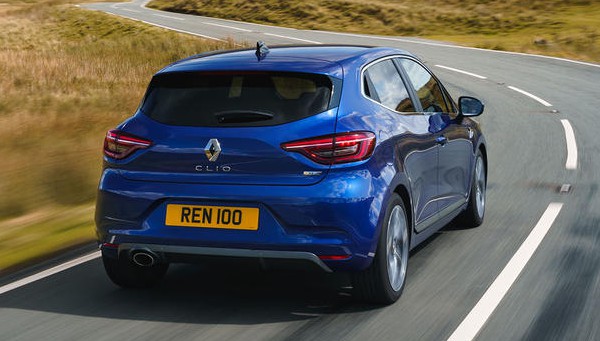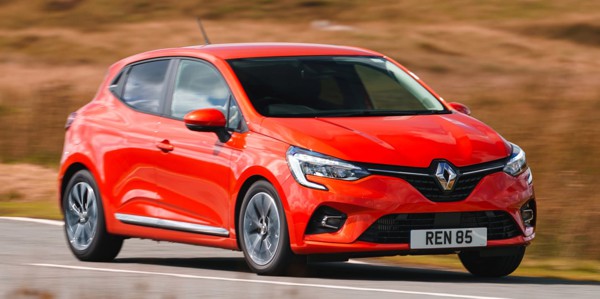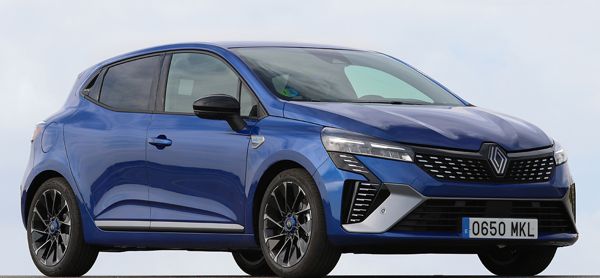Published
on 1
Apr 2020
|
All rights reserved.
|
|
|

|
|
In
its 5th generation, Clio is set to retain its European sales crown.
|
|
Renault
is proud that the outgoing Clio IV managed to increase sales every year
in Europe since its lanuch in 2012. Most impressive, even in its final
year, it still ranked first at the European B-segment sales chart,
beating the newer Volkswagen Polo and Ford Fiesta. The Clio IV was
neither the best to drive (that’s Ford Fiesta) nor the most comfortable
(VW Polo), but it was a well-rounded package that combined pretty
looks, high practicality, decent dynamics and refinement as well as
good value for money, just in line with the tradition of French small
cars. This explains why it rarely ranked top in contests, but
ultimately shone in sales chart. Car buyers are not foolish.
Coming to the 5th generation, the Clio has no signs of fatigue. In
fact, we would say it seems stronger than how its predecessor looked
when new. This starts from the exterior design. The outgoing Clio was
the first Renault penned under the direction of Laurens van den Acker.
As it won a lot of loves, there is no reason to change too much.
Therefore, this time the design is evolutionary. It keeps the general
profile and signature features like the logo-concentric nose grille and
“hidden” rear door handles. However, the nose grille is refined
further, and new C-shape headlamps give it a smarter appearance. The
body sides and tailgate are more sculpted, now served with some subtle
crease lines to deliver a higher sense of quality under light
reflection. There are also chromed window frames on higher spec. models
to deliver a more expensive feeling. Overall, this is probably the
prettiest car in the B-segment, losing to the new Peugeot 208 only in
terms of character.

|
|
Chromed
window frames on higher spec. models deliver a more expensive feeling.
|
|
The Clio V is the first Renault built on the CMF-B platform, which was
first used by Nissan Micra in 2017. To consumers, this information is
not much useful though, as its mechanical layout is no different to
just about any cars in the class. A pair of MacPherson strut
suspensions up front, a semi-independent torsion-beam axle at the back,
electric power steering, a series of 3 or 4-cylinder turbocharged
engines, lots of electronic driving aids and safety features provided
by much the same global suppliers… These days you won’t find novel
technologies like Citroen’s hydro-pneumatic suspension anymore, at
least on econo cars, because the call for maximizing economy of scale
grows beyond a manufacturer or even a group can manage. Moreover,
Renault has long lost the desire to innovate under the philosophy of Le
Cost Killer. Therefore, the Clio follows strictly the industrial
standards in terms of engineering, although it follows the trend
closely enough. It offers a long list of driving assistance, such as
adaptive cruise control, lane keeping assist, automatic parking, active
emergency braking, 360-degree cameras etc. Instead of spending money on
developing new technologies, Renault chose to use the money to equip
the car better, offering more value for money.
The Clio V is a little bit shorter than the old car but 66mm wider.
This makes it the widest car in the segment as well, which should help
handling. Its 2583mm wheelbase is a few millimeters shorter than
before, but still longer than all of its key rivals. The old car was
not renowned for space efficiency. The new car, while improved a little
in this respect, is still far from remarkable. Its cabin space is about
average in the class, matching a Fiesta, 208 or Corsa but not quite as
roomy as Polo or Ibiza, particularly for rear passengers. Renault
claims it manages to improve rear legroom by 26mm despite the shorter
wheelbase, thanks to using thinner front seats, but the VW group duo
still offers noticeably more legroom, and the Clio is short of rear
headroom as well. So where does the space go? The answer is the boot,
which is a class-leading 391 liters. That’s 40 liters more than VW and
88 liters more than Ford! In fact, it is larger than even the last
generation Golf or many C-segment hatchbacks. Besides, the Clio’s boot
is easy to access, thanks to large tailgate and relatively low boot lip.

|
|
The
interior of Clio V is one of the most remarkable.
|
|
The interior of Clio V is one of the most remarkable. It is quite
stylish and tasteful, thanks to a minimalist design. It feels roomy and
airy, thanks to the horizontal dashboard and the availability of
lighter 2-tone color schemes. It looks smart, thanks to a large,
9.3-inch tablet touchscreen. It feels ergonomically sounded, thanks to
some conventional HVAC rotary controls, piano buttons, higher placement
of gearstick and a multi-adjustable steering wheel, although the driver
seat cannot be adjusted low enough. It even feels premium, thanks to
using soft-touch plastics on dash top and doors, as well as well-damped
switches and a leather-wrapped steering wheel. Admittedly, that’s on
the higher-spec models only, while cheaper trims still employ plenty of
hard and grey plastics as well as a smaller touchscreen. Still, the
French car’s cabin looks more inviting and less boring than Volkswagen
group’s products.
The largest 9.3-inch touchscreen displays sharp graphics while the
smaller 7-inch item is not that good. The software is far from
sophisticated, but its icon-based user interface needs no learning
curve. You can also customize its home screen, putting most
frequently-used functions there. Standard equipment is abundant,
including sat-nav, Bluetooth, Apple CarPlay and Android Auto.
 |
|
Powertrains
leave something to desire, but refinement is always superb.
|
|
As expected, the new monocoque chassis employs more high-strength steel
and structural adhesives, boosting rigidity while cutting 22kg of
weight from the body-in-white. Noise suppression is improved by using
laminated windscreen, double-sealed doors and windows and more sound
deadening materials in the engine compartment. Apart from wider tracks,
handling should be improved by stiffer suspension tuning and a
5-percent quicker steering rack.
On the road, the Clio feels agile, well balanced yet comfortable. Its
suspension setting is well judged. Maybe biased towards the comfort
side a little bit, so it is supple and quiet, more comfortable than
anything in the class bar VW Polo. However, this does not sacrifice too
much body control. In fact, compared with the old Clio it feels a lot
more composed. Perhaps due to the wider tracks, stiffer body or better
suspension tuning, the new Clio slips through successive turns
fluently. Its steering is good. Not as sharp or as sporty-feeling as
Ford’s, but delicate and accurate. It is light when driven leisurely,
adequate for a city car, but loads up as you push harder. The car
steers eagerly, and the chassis is well balanced. Unlike Volkswagen
group cars, the Clio does not major on grip and stability. Its tires
offer just enough grip to feel safe in normal driving, but once you
push them beyond their modest limit, you can balance the car on
throttle. Lift off throttle abruptly will tuck its nose in. Harder
still will see its tail steps out a little. Ford Fiesta has been famous
for playing this trick. Now it is not alone.
However, the Renault still cannot match Ford for driving thrills. Its
steering is neither as weighty nor as communicative. Its body control
is relatively loose. Its cornering limit is probably lower. There is
certainly some playfulness here, but the Clio is still more about an
easy-going road manner – absorbent, quiet, agile and lightweight
controls. It is a good way to give ordinary drivers a taste of fun
without sacrificing comfort. In contrast, a Fiesta is designed to
please keen drivers who are willing to sacrifice some ride comfort.

|
|
The
Clio feels agile, well balanced yet comfortable.
|
|
Keener drivers might find the Clio a little slow, too. There are 3
petrol, 1 diesel and 1 hybrid powertrain on offer, but the largest
selling should be the 100hp 1.0-liter TCe 100 engine. Upgraded from the
old 0.9-liter unit, this turbocharged 3-cylinder is a little bit
stronger and more responsive, but it still trails the rivalling
3-cylinder engines from Ford, VW and PSA. Maybe due to the lack of
direct injection, its power delivery is lazier, taking 2750rpm to
produce its peak torque of 118lbft. In contrast, its rivals need 1500
or 1750 rpm to realize more peak torque. This reflects in performance,
where the Clio trails its rivals from 0-60 by a second or so, taking
more than 11 seconds. Moreover, the motor feels strained when asked to
rev beyond 5000 rpm, lacking the eager top end of its rivals. On the
plus side, driven in normal conditions, the Renault motor is just as
refined as the rest of the car. It feels hushed and torquey enough in
the mid-range. The 5-speed manual gearbox might lack a ratio, but it is
geared such as the engine turns at 3000 rpm when cruising at 70 mph. No
wonder the Clio is remarkably quiet in cruising, almost as quiet as
Polo, the refinement leader in the class.
If the 3-cylinder turbo is not punchy enough, you can forget its 72hp
naturally aspirated version, because it takes more than 15 seconds to
go from 0-60. A better but more expensive option is a 1.33-liter
4-cylinder turbo of TCe 130. Developed jointly with Mercedes (and
adopted on A and B-class at higher state of tune), this one gets direct
injection and a respectable 130hp. So is it a new R5 Turbo? Not quite.
It manages 0-60 in a lukewarm 8.5 seconds. That’s the same as what
quoted by a Fiesta 1.0 Ecoboost 140hp, but ridiculously, Renault’s
4-pot engine sounds harsh when revved (the same as we found on the
A-class), feeling less polished and less characterful than Ford’s
3-cylinder.
The 5-speed manual of TCe 100 is not a great gearbox, blame to a
rubbery gearshift. The Getrag-built 7-speed DCT mandatory to TCe 130 is
not perfect either, as it is a bit slow, especially when using paddles.
If the upcoming Clio RS adopts the 1.8 engine and gearbox of Alpine
A110, it could be a formidable rival to Ford Fiesta ST. As the cooking
model does not, it is not going to be the choice of keen drivers.
However, benefited with a pretty look, a smart interior and a blend of
superb refinement, supple ride quality and decent handling, in addition
to great value for money, the new Clio is definitely a strong player in
the class. Its European sales crown seems to be secured.
|
Verdict:    
|
Published
on 6
Nov 2023
|
All rights reserved.
|
|
Clio facelift (2023)
|
|

|
|
Still
a great supermini, but lacks firepower to match its new looks.
|
|
The
2023 facelift of Renault Clio brings a sharper and more upmarket facia
which is reminiscent of the facelift received by Clio II in 2001. It looks more
serious and less cute than the original design, not quite coherent with
the rest of the car in my opinion, but it is probably necessary
considering the B-segment supermini is getting more and more expensive
to buy. One of the reasons is the tightening of emission standards,
which forces the Clio to adopt hybrid technology. More on that later.
Apart from facelift, the Clio gets slightly updated interior trims and
infotainment software. All models now get a portrait touchscreen, in
either 7 or 10-inch. Seats and cabin space are unchanged, so its rear
bench remains a little tight for adults.
The Clio V has been renowned for great balance between handling and
ride, and this continues in the facelifted car. It is more interesting
to drive than most rivals in the class, yet retains an absorbent ride
that makes it a pleasure to drive on back roads and in town.
Tightening emission standard forces Renault to drop the TCe 100
3-cylinder and TCe130 4-cylinder turbo engines, leaving the entry-level
TCe 90 to soldier on. It takes 11.5 seconds to go from rest to 60 mph.
If you want a step forward, the only option is E-Tech Hybrid. Renault’s
patented hybrid system combines a 1.6-liter 4-port petrol engine with 2
electric motors, a 4-speed clutchless gearbox and a 1.2 kWh battery. To
cut costs, the petrol engine employs no turbo, no variable valve timing
and no direct injection. That sounds awful, but since the engine is
assisted by electric motor, the lack of turbocharging is not a big
problem. Moreover, electric assistance allows the engine to run at its
optimum rev range, so VVT and direct injection can be skipped. It
produces 94 horsepower and 108 lbft of torque.
Sitting beside the engine is the transmission/motor combo. A larger,
ring-shaped propulsion motor produces 49 hp and 151 lbft of torque,
while a smaller, 22 hp motor acts as starter generator. At low speed,
the latter can supply the propulsion motor like a series hybrid.
The 4-speed clutchless gearbox is the most innovative part of the
hybrid system. Again to cut costs and weight, it ditches conventional
synchronizers and opts for dog clutches. Normally this would have
resulted in very harsh gearshifts, but the smaller motor spins the
first gear to match its speed and smooth out the gear engagement. The
hybrid system can be configured in multiple modes, allowing the engine
and propulsion motor to work exclusively or together. Combined output
is 143 hp and 151 lbft.
The power figure sounds remarkable, but in reality the system works
leisurely to ensure smooth operation. In normal driving, it works
really well. Engine noise falls into the background and gearshift is
almost imperceptible. It is frugal, too, especially in urban driving.
However, if you are in a hurry, you will find the automatic gearshift –
there is no manual mode – slow, and revving the engine hard will
generate a lot of noise. It is by no means a hot hatch or warm hatch.
Speaking of hot hatch, the Clio V still lacks an RS model. The E-Tech
Hybrid can be ordered in Alpine trim which comes with 17-inch wheels
and other cosmetic upgrades. Renault has no plan to bring back the Clio
RS nameplate. Instead, all efforts will be spent to the Alpine version
of electric R5. As a result, this generation of Clio will never be as
memorable as its predecessors, even though it is probably the best
supermini on the market now.
|
Verdict:    
|
|